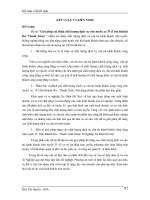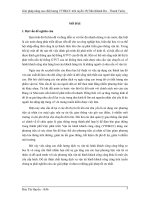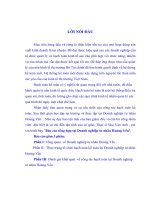35 short run tradeoff
Bạn đang xem bản rút gọn của tài liệu. Xem và tải ngay bản đầy đủ của tài liệu tại đây (779.4 KB, 7 trang )
Unemployment and Inflation
The Short-Run
Tradeoff between
Inflation and
Unemployment
35
Copyright © 2004 South-Western
• The natural rate of unemployment depends on
various features of the labor market.
• Examples include minimum-wage laws, the
market power of unions, the role of efficiency
wages, and the effectiveness of job search.
• The inflation rate depends primarily on growth
in the quantity of money, controlled by the Fed.
Copyright © 2004 South-Western
Unemployment and Inflation
• Society faces a short-run tradeoff between
unemployment and inflation.
• If policymakers expand aggregate demand, they
can lower unemployment, but only at the cost
of higher inflation.
• If they contract aggregate demand, they can
lower inflation, but at the cost of temporarily
higher unemployment.
Copyright © 2004 South-Western
Figure 1 The Phillips Curve
• The Phillips curve illustrates the short-run
relationship between inflation and
unemployment.
Copyright © 2004 South-Western
Aggregate Demand, Aggregate Supply, and
the Phillips Curve
• The Phillips curve shows the short-run
combinations of unemployment and inflation
that arise as shifts in the aggregate demand
curve move the economy along the short-run
aggregate supply curve.
Inflation
Rate
(percent
per year)
B
6
THE PHILLIPS CURVE
A
2
Phillips curve
0
4
7
Unemployment
Rate (percent)
Copyright © 2004 South-Western
Copyright © 2004 South-Western
1
Figure 2 How the Phillips Curve is Related to
Aggregate Demand and Aggregate Supply
Aggregate Demand, Aggregate Supply, and
the Phillips Curve
• The greater the aggregate demand for goods
and services, the greater is the economy’s
output, and the higher is the overall price level.
• A higher level of output results in a lower level
of unemployment.
(a) The Model of Aggregate Demand and Aggregate Supply
Price
Level
B
6
B
106
A
102
0
(b) The Phillips Curve
Inflation
Rate
(percent
per year)
Short-run
aggregate
supply
High
aggregate demand
Low aggregate
demand
7,500 8,000
(unemployment (unemployment
is 7%)
is 4%)
A
2
Phillips curve
Quantity
of Output
0
4
(output is
8,000)
Unemployment
7
(output is Rate (percent)
7,500)
Copyright © 2004 South-Western
Copyright © 2004 South-Western
SHIFTS IN THE PHILLIPS CURVE:
THE ROLE OF EXPECTATIONS
The Long-Run Phillips Curve
• The Phillips curve seems to offer policymakers
a menu of possible inflation and unemployment
outcomes.
• In the 1960s, Friedman and Phelps concluded
that inflation and unemployment are unrelated
in the long run.
• As a result, the long-run Phillips curve is vertical at
the natural rate of unemployment.
• Monetary policy could be effective in the short run
but not in the long run.
Copyright © 2004 South-Western
Figure 4 How the Phillips Curve is Related to
Aggregate Demand and Aggregate Supply
Figure 3 The Long-Run Phillips Curve
Inflation
Rate
Copyright © 2004 South-Western
Long-run
Phillips curve
(a) The Model of Aggregate Demand and Aggregate Supply
Price
Level
High
1. When the
inflation
Fed increases
the growth rate
of the money
supply, the
rate of inflation
increases . . .
Low
inflation
B
P2
2. . . . raises
the price
P
level . . .
A
2. . . . but unemployment
remains at its natural rate
in the long run.
Long-run aggregate
supply
1. An increase in
the money supply
increases aggregate
B
demand . . .
A
(b) The Phillips Curve
Inflation
Rate
Long-run Phillips
curve
3. . . . and
increases the
inflation rate . . .
B
A
AD2
Aggregate
demand, AD
0
Natural rate
of output
Quantity
of Output
0
Natural rate of
unemployment
Unemployment
Rate
4. . . . but leaves output and unemployment
at their natural rates.
0
Natural rate of
unemployment
Unemployment
Rate
Copyright © 2004 South-Western
Copyright © 2004 South-Western
2
Expectations and the Short-Run Phillips
Curve
Expectations and the Short-Run Phillips
Curve
• Expected inflation measures how much people
expect the overall price level to change.
• In the long run, expected inflation adjusts to
changes in actual inflation.
• The Fed’s ability to create unexpected inflation
exists only in the short run.
• Once people anticipate inflation, the only way to get
unemployment below the natural rate is for actual
inflation to be above the anticipated rate.
Copyright © 2004 South-Western
Figure 5 How Expected Inflation Shifts the ShortRun Phillips Curve
Expectations and the Short-Run Phillips
Curve
Unemployment Rate =
(
Actual − Expected
Natural rate of unemployment - a inflation
inflation
Copyright © 2004 South-Western
)
Inflation
Rate
• This equation relates the unemployment rate to
the natural rate of unemployment, actual
inflation, and expected inflation.
2. . . . but in the long run, expected
inflation rises, and the short-run
Phillips curve shifts to the right.
Long-run
Phillips curve
C
B
Short-run Phillips curve
with high expected
inflation
A
1. Expansionary policy moves
the economy up along the
short-run Phillips curve . . .
0
Copyright © 2004 South-Western
Short-run Phillips curve
with low expected
inflation
Natural rate of
unemployment
Unemployment
Rate
Copyright © 2004 South-Western
The Natural Experiment for the Natural-Rate
Hypothesis
The Natural Experiment for the Natural Rate
Hypothesis
• The view that unemployment eventually returns
to its natural rate, regardless of the rate of
inflation, is called the natural-rate hypothesis.
• Historical observations support the natural-rate
hypothesis.
• The concept of a stable Phillips curve broke
down in the in the early ’70s.
• During the ’70s and ’80s, the economy
experienced high inflation and high
unemployment simultaneously.
Copyright © 2004 South-Western
Copyright © 2004 South-Western
3
Figure 6 The Phillips Curve in the 1960s
Figure 7 The Breakdown of the Phillips Curve
Inflation Rate
(percent per year)
Inflation Rate
(percent per year)
10
10
8
8
6
6
1973
1971
4
4
1967
2
0
1969
1968
1968
1966
1967
1962
1965
1964
1963
1
2
3
4
5
1970
6
2
8
9
10 Unemployment
0
Rate (percent)
1966
1962
1965
1964
1963
1961
7
1972
1
2
3
4
5
6
1961
7
8
9
10 Unemployment
Rate (percent)
Copyright © 2004 South-Western
Copyright © 2004 South-Western
SHIFTS IN THE PHILLIPS CURVE:
THE ROLE OF SUPPLY SHOCKS
SHIFTS IN THE PHILLIPS CURVE:
THE ROLE OF SUPPLY SHOCKS
• Historical events have shown that the short-run
Phillips curve can shift due to changes in
expectations.
• The short-run Phillips curve also shifts because
of shocks to aggregate supply.
• Major adverse changes in aggregate supply can
worsen the short-run tradeoff between
unemployment and inflation.
• An adverse supply shock gives policymakers a less
favorable tradeoff between inflation and
unemployment.
Copyright © 2004 South-Western
SHIFTS IN THE PHILLIPS CURVE:
THE ROLE OF SUPPLY SHOCKS
• A supply shock is an event that directly alters
the firms’ costs, and, as a result, the prices they
charge.
• This shifts the economy’s aggregate supply
curve. . .
• . . . and as a result, the Phillips curve.
Copyright © 2004 South-Western
Figure 8 An Adverse Shock to Aggregate Supply
(a) The Model of Aggregate Demand and Aggregate Supply
Price
Level
3. . . . and
raises
the price
level . . .
AS2
P2
B
A
P
Aggregate
supply, AS
1. An adverse
shift in aggregate
supply . . .
Y2
Y
2. . . . lowers output . . .
Quantity
of Output
4. . . . giving policymakers
a less favorable tradeoff
between unemployment
and inflation.
B
A
PC2
Aggregate
demand
0
Copyright © 2004 South-Western
(b) The Phillips Curve
Inflation
Rate
Phillips curve, P C
0
Unemployment
Rate
Copyright © 2004 South-Western
4
SHIFTS IN THE PHILLIPS CURVE:
THE ROLE OF SUPPLY SHOCKS
• In the 1970s, policymakers faced two choices
when OPEC cut output and raised worldwide
prices of petroleum.
Figure 9 The Supply Shocks of the 1970s
Inflation Rate
(percent per year)
10
1980
1974
8
• Fight the unemployment battle by expanding
aggregate demand and accelerate inflation.
• Fight inflation by contracting aggregate demand
and endure even higher unemployment.
1981
1975
1979
1978
6
1977
1973
4
1976
1972
2
0
1
2
3
4
5
6
7
8
9
10 Unemployment
Rate (percent)
Copyright © 2004 South-Western
THE COST OF REDUCING
INFLATION
• To reduce inflation, the Fed has to pursue
contractionary monetary policy.
policy
• When the Fed slows the rate of money growth,
it contracts aggregate demand.
• This reduces the quantity of goods and services
that firms produce.
• This leads to a rise in unemployment.
Copyright © 2004 South-Western
Figure 10 Disinflationary Monetary Policy in the
Short Run and the Long Run
Inflation
Rate
1. Contractionary policy moves
the economy down along the
short-run Phillips curve . . .
A
Short-run Phillips curve
with high expected
inflation
C
B
Short-run Phillips curve
with low expected
inflation
0
Copyright © 2004 South-Western
Long-run
Phillips curve
Natural rate of
unemployment
Unemployment
2. . . . but in the long run, expected Rate
inflation falls, and the short-run
Phillips curve shifts to the left.
Copyright © 2004 South-Western
THE COST OF REDUCING
INFLATION
THE COST OF REDUCING
INFLATION
• To reduce inflation, an economy must endure a
period of high unemployment and low output.
• The sacrifice ratio is the number of percentage
points of annual output that is lost in the
process of reducing inflation by one percentage
point.
• When the Fed combats inflation, the economy
moves down the short-run Phillips curve.
• The economy experiences lower inflation but at the
cost of higher unemployment.
Copyright © 2004 South-Western
• An estimate of the sacrifice ratio is five.
• To reduce inflation from about 10% in 1979-1981
to 4% would have required an estimated sacrifice of
30% of annual output!
Copyright © 2004 South-Western
5
Rational Expectations and the Possibility of
Costless Disinflation
Rational Expectations and the Possibility of
Costless Disinflation
• The theory of rational expectations suggests
that people optimally use all the information
they have, including information about
government policies, when forecasting the
future.
• Expected inflation explains why there is a
tradeoff between inflation and unemployment
in the short run but not in the long run.
• How quickly the short-run tradeoff disappears
depends on how quickly expectations adjust.
Copyright © 2004 South-Western
Rational Expectations and the Possibility of
Costless Disinflation
• The theory of rational expectations suggests
that the sacrifice-ratio could be much smaller
than estimated.
Copyright © 2004 South-Western
The Volcker Disinflation
• When Paul Volcker was Fed chairman in the
1970s, inflation was widely viewed as one of
the nation’s foremost problems.
• Volcker succeeded in reducing inflation (from
10 percent to 4 percent), but at the cost of high
employment (about 10 percent in 1983).
Copyright © 2004 South-Western
Figure 11 The Volcker Disinflation
The Greenspan Era
Inflation Rate
(percent per year)
10
A
• Alan Greenspan’s term as Fed chairman began
with a favorable supply shock.
1980 1981
1979
8
6
1984
1987
C
2
0
• In 1986, OPEC members abandoned their
agreement to restrict supply.
• This led to falling inflation and falling
unemployment.
1982
4
1
2
3
4
5
6
Copyright © 2004 South-Western
B
1983
1985
1986
7
8
9
10 Unemployment
Rate (percent)
Copyright © 2004 South-Western
Copyright © 2004 South-Western
6
Figure 12 The Greenspan Era
The Greenspan Era
Inflation Rate
(percent per year)
• Fluctuations in inflation and unemployment in
recent years have been relatively small due to
the Fed’s actions.
10
8
6
1990
1991
1989
1984
1988
1985
2001 1987
1995
1992
2000
1986
1997
1994
1993
1999
1998 1996 2002
4
2
0
1
2
3
4
5
6
7
8
9
10 Unemployment
Rate (percent)
Copyright © 2004 South-Western
Summary
Copyright © 2004 South-Western
Summary
• The Phillips curve describes a negative
relationship between inflation and
unemployment.
• By expanding aggregate demand, policymakers
can choose a point on the Phillips curve with
higher inflation and lower unemployment.
• By contracting aggregate demand,
policymakers can choose a point on the Phillips
curve with lower inflation and higher
unemployment.
• The tradeoff between inflation and
unemployment described by the Phillips curve
holds only in the short run.
• The long-run Phillips curve is vertical at the
natural rate of unemployment.
Copyright © 2004 South-Western
Copyright © 2004 South-Western
Summary
Summary
• The short-run Phillips curve also shifts because
of shocks to aggregate supply.
• An adverse supply shock gives policymakers a
less favorable tradeoff between inflation and
unemployment.
• When the Fed contracts growth in the money
supply to reduce inflation, it moves the
economy along the short-run Phillips curve.
• This results in temporarily high unemployment.
• The cost of disinflation depends on how quickly
expectations of inflation fall.
Copyright © 2004 South-Western
Copyright © 2004 South-Western
7








